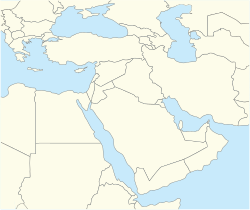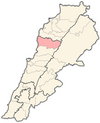Byblos
Byblos
جُبَيْل Jebeil | |
|---|---|
City | |
 Byblos Old Town | |
| Coordinates:34°07′25″N35°39′07″E/ 34.12361°N 35.65194°E | |
| Country | Lebanon |
| Governorate | Keserwan-Jbeil |
| District | Byblos |
| Area | |
| • City | 4.16 km2(1.61 sq mi) |
| • Metro | 17 km2(7 sq mi) |
| Population | |
| • City | 40,000 |
| •Metro | 100,000 |
| Time zone | UTC+2(EET) |
| • Summer (DST) | UTC+3(EEST) |
| Dialing code | +961 |
| Website | www |
| Criteria | Cultural: iii, iv, vi |
| Reference | 295 |
| Inscription | 1984 (8thSession) |
Byblos(/ˈbɪblɒs/BIB-loss;Greek:Βύβλος), also known asJebeil,JbeilorJubayl(Arabic:جُبَيْل,romanized:Jubayl,locallyJbeil[ʒ(ə)beːl];Phoenician:𐤂𐤁𐤋,GBL,probablyGebal), is an ancient city in theKeserwan-Jbeil GovernorateofLebanon.The area is believed to have been first settled between 8800 and 7000BC[1]and continuously inhabited since 5000BC.[2]During its history, Byblos was part of numerous cultures includingEgyptian,Phoenician,Assyrian,Persian,Hellenistic,Roman,Genoese,MamlukandOttoman.Urbanisation is thought to have begun during the third millennium BC and it developed into a city[3][2]making it one of theoldest cities in the world.It is aUNESCOWorld Heritage Site.[4]
It was in ancient Byblos that thePhoenician Alpha bet,likely the ancestor of theGreek,Latinand all other Western Alpha bets, was developed.[5]
Etymology[edit]
| kbnj[6] inhieroglyphs | |||
|---|---|---|---|
| Era:1st Intermediate Period (2181–2055 BC) | |||
| kbn[6][7] inhieroglyphs | |||
|---|---|---|---|
| Era:Middle Kingdom (2055–1650 BC) | |||
Eusebius'Onomasticonstated that Byblos was known in Hebrew as Gabel / Gobel.[8]The name appears asKebnyinEgyptianhieroglyphicrecords going back to the4th-dynastypharaohSneferu(fl. 2600BC)[9]and asGubla(𒁺𒆷) in theAkkadiancuneiformAmarna lettersto the18th-dynastypharaohsAmenhotep IIIandIV.In the 1stmillenniumBC, its name appeared inPhoenicianandPunicinscriptions asGebal(𐤂𐤁𐤋,GBL);[10][11]in theHebrewBibleasGeval(גבל);[12]and inSyriacasGBL(ܓܒܠ). The name seems to derive fromGB(𐤂𐤁,"well") andʾL(𐤀𐤋,"god"), the latter a word that could variously refer toany of the Canaanite godsor totheir leader in particular.The name thus seems to have meant the "Well of the God" or "Source of the God".
Its presentArabicnameJubayl(جبيل) orJ(e)beilis a direct descendant of these earlier names, although apparently modified by a misunderstanding of the name as thetriliteral rootGBLorJBL,meaning "mountain".When the Arabic form of the name is used, it is typically renderedJbeil,Jbail,orJbaylin English.[citation needed]All of these, along with Byblos, are etymologically related. During theCrusades,this name appeared in European records asGibeletorGiblet.This name was used forByblos Castleandits associated lordship.
The Phoenician city, known to the Greeks asBýblos(Βύβλος) and to the Romans asByblus,was important for their import ofpapyrusfromEgypt[13]– to the extent that "byblos"came to mean" papyrus "in Greek. TheEnglishword "Bible",therefore, ultimately derives from the Greek name of the city.[14][15][16]
History and archaeology[edit]

Situated approximately 42 km (26 mi) north ofBeirut,Byblos holds a strong allure for archaeologists due to its accumulations of various strata resulting from countless centuries of human dwelling. The initial excavation was conducted byErnest Renanin 1860, documented in his work"Mission de Phénicie" (1865–1874).This was succeeded byPierre Montet's efforts from 1921 to 1924, and later byMaurice Dunand,who continued excavations from 1925 for a span of forty years.[17][18]Renan's expedition was to "provide the evidence that the city did not move and that Gebeil is Byblos".[19]
Fragments attributed to the semi-legendary pre-HomericPhoenicianpriestSanchuniathonsay Byblos was the first city erected inPhoeniciaand was established by the godCronus.[20](Cronus was considered the nearest equivalent to the CanaaniteBaalorBaal Hammoninthe syncretising systemused by the ancient Greeks and Romans.) According to the writerPhilo of Byblos(quoting Sanchuniathon, and quoted inEusebius), Byblos was founded by the Phoenician shrine godEl,(whom theGreeksidentified with their godCronus). During the 3rd millennium BC, the first signs of atowncan be observed, with the remains of well-built houses of uniform size. This was the period when theCanaanitecivilization began to develop.
Neolithic and Chalcolithic levels[edit]
Neolithicremains of some buildings can be observed at the site.Jacques Cauvinpublished studies offlint toolsfrom the stratified Neolithic andChalcolithicsites in 1962.[21]Remains of humans found in Chalcolithic burials have been published byHenri Victor Valloisin 1937.[22]Tombs from this era were discussed by EmirMaurice Chehabin 1950.[23]Early pottery found at the tell was published by E.S. Boynton in 1960 with further studies by R. Erich in 1954 and Van Liere andHenri de Contensonin 1964.[24][25][26]
Dunand's five-level stratigraphy[edit]
Prehistoric settlements at Byblos were divided up by Dunand into the following five periods, which were recently expanded and re-calibrated byYosef Garfinkelto correlate withTell es-Sultan(Jericho):
- Early Neolithic (early phase) corresponding to thePre-Pottery Neolithic B(PPNB) of Jericho, represented by plastered floors andnaviformetechnology, dated between 8800 and 7000 BC;
- Early Neolithic (late phase) corresponding to thePNAofTell es-Sultan(Jericho) IX (alsoYarmukian) between 6400 and 5800 BC, represented bypottery,sickleblades,figurinesand small points;
- Middle Neolithic corresponding to thePNBofTell es-Sultan(Jericho) VIII and represented by pottery, dated between 5800 and 5300 BC;
- Late Neolithic corresponding to the MiddleChalcolithicofBeth Sheanand represented by pottery, stone vessels,silos,chamber tombsand seals, dated between 5300 and 4500 BC;
- Early Chalcolithic corresponding to the Late Chalcolithic ofGhassulian,represented byjar burials,pierced flint, churn and a violin figurine, dated to between 4500 and 3600 BC and,
- Late Chalcolithic corresponding to the EarlyBronze Age,represented byarchitectureandcylinder sealimpressions, dated to between 3600 and 3100 BC.[1]
The site first appears to have been settled during thePre-Pottery Neolithic Bperiod, approximately 8800 to 7000 BC[1][27](Durand's Early Neolithic).
Early Neolithic Byblos was a later settlement than others in theBeqaa Valleysuch asLabwehandArd Tlaili.It was located on the seaward slope of the larger of the two hills that used to compose ancient Byblos, with a watered valley in between.[28]

The original site spread down into the valley and covered an area of 1.2 ha (3.0 acres) providing fertile soils and a protected landing place for boats. Dunand discovered around twenty houses although some of the settlement was suggested to have been lost to the sea, robbed or destroyed.[18][29][30][31][32][33][34]Dwellings were rectangular with plastered floors,potterywas usuallyDark faced burnished warewith some shell impressions.[35]
The Middle Neolithic was a smaller settlement of no more than 0.15 ha (0.37 acres) adjacent to the older site. The pottery was more developed with red washes and more varied forms and elaborate decorations, buildings were poorer with unplastered floors.
The Late Neolithic period showed development from the middle in building design, a wider range of more developed flint tools and a far larger variety of pottery with fabrication including silica. The Late Chalcolithic featured developments of "Canaanean blades"and fan scrapers. Adult burials in jars started to appear along with metal in the form of onecopperhook, found in a jar. Some jars were lined with white plaster that was applied and self-hardened after firing.[36]Copper appeared more frequently in the Late Chalcolithic period along with multiple burials in tombs and jar handles with impressed signs.[24]

Early Bronze[edit]
According toLorenzo Nigro,Byblos moved from being a fishermen's village to its earlier urban form at the beginning of the third millennium BC.[37]Early Bronze Age remains were characterised by the development ofByblos combed wareand a lithic assemblage studied by Jacques Cauvin.[28][38]
Watson Mills and Roger Bullard suggest that during theOld Kingdom of EgyptandMiddle Kingdom of EgyptByblos was virtually an Egyptian colony.[17]The growing city was a wealthy one and seems to have been an ally (among "those who are on his waters" ) ofEgyptfor many centuries.First Dynastytombs used timbers from Byblos. One of the oldest Egyptian words for an oceangoing boat was "Byblos ship". Archaeologists have recoveredEgyptian-made artifacts as old as a vessel fragment bearing the name of theSecond dynastyrulerKhasekhemwy,although this "may easily have reached Byblos through trade and/or at a later period".[39]
Middle Bronze[edit]
Objects have been found at Byblos naming the 13th Dynasty Egyptian kingNeferhotep I.
Late Bronze[edit]
The rulers of Byblos maintained close relationships with the New Kingdom pharaohs of Ancient Egypt
Around 1350 BC, theAmarna lettersinclude 60 letters fromRib-Haddaand his successorIli-Rapihwho were rulers of Byblos, writing to the Egyptian government. This is mainly due to Rib-Hadda's constant pleas for military assistance fromAkhenaten.They also deal with the conquest of neighbouring city-states by theHabiru.
It appears Egyptian contact peaked during the19th dynasty,only to decline during the20thand21stdynasties. In addition, when theNew Kingdomcollapsed in the 11th century BC, Byblos ceased being a colony and became the foremost city of Phoenicia.[40]Although the archaeological evidence seems to indicate a brief resurgence during the22ndand23rddynasties, it is clear after theThird Intermediate Periodthe Egyptians started favouringTyreandSidoninstead of Byblos.[41]
Archaeological evidence at Byblos, particularly the fiveByblian royal inscriptionsdating back to around 1200–1000 BC, shows existence of aPhoenician Alpha betof twenty-two characters; an important example is theAhiram sarcophagus.The use of the Alpha bet was spread by Phoenician merchants through their maritime trade into parts of North Africa and Europe. One of the most important monuments of this period is theTemple of the Obelisks,dedicated to theCanaanite war godResheph,but this had fallen into ruins by the time ofAlexander the Great.

Iron Age[edit]
In theAssyrianperiod,Sibittibaalof Byblos became tributary toTiglath-Pileser IIIin 738 BC, and in 701 BC, whenSennacheribconquered allPhoenicia,the king of Byblos wasUrumilki.Byblos was also subject to Assyrian kingsEsarhaddon(r. 681–669 BC) andAshurbanipal(r. 668–627 BC), under its kingsMilkiasaphandYehawmelek.
In theAchaemenid Empire(538–332 BC), Byblos was the fourth of four Phoenician vassal kingdoms established by the Persians; the first three beingSidon,Tyre,andArwad.
Classical antiquity[edit]
Hellenisticrule came with the arrival ofAlexander the Greatin the area in 332 BC.Coinagewas in use, and there is abundant evidence of continued trade with other Mediterranean countries.


During theGreco-Romanperiod, the temple ofReshephwas elaborately rebuilt, and the city, though smaller than its neighbours such as Tyre and Sidon, was a centre for the cult ofAdonis.
KingHerodofJudaea,known for his extensive building projects, including beyond his own kingdom, constructed a city wall for Byblos.[42]
In the 3rd century, a small but impressivetheatrewas constructed. With the rise ofChristianity,abishopricwas established in Byblos, and the town grew rapidly. Although aSasaniancolony is known to have been established in the region following theearly Muslim conquestsof 636, there is little archaeological evidence for it. Trade withEuropeeffectively dried up, and it was not until the coming of theFirst Crusadein 1098 that prosperity returned to Byblos, known then as Gibelet or Giblet.
Crusader, Mamluk, Ottoman period[edit]
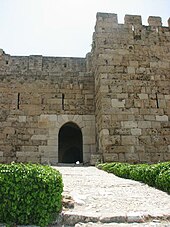

In the 12th and 13th century, Byblos became part of theCounty of Tripoli,aCrusader stateconnected to, butlargely independentfrom, theCrusaderKingdom of Jerusalem.
As Gibelet or Giblet, it came under the rule of theGenoeseEmbriaco family,who created for themselves theLordship of Gibelet,first as administrators of the city in the name of theRepublic of Genoa,and then as a hereditary fief, undertaking to pay an annual fee to Genoa and thechurch of San Lorenzo(Genoa's Cathedral).[43]
The Embriaco family's residence, theCrusader castle of Gibelet,along with the fortified town, served as an important military base for the Crusaders. The remains of the castle are among the most impressive architectural structures now visible in the town centre. The town was taken bySaladinin 1187, re-taken by the Crusaders, and conquered byBaibarsin 1266, but it remained in the possession of the Embriacos until around 1300.
Having voluntarily surrendered to the Mamluks, the city was relatively spared from looting following its capture.[44]Its fortifications were subsequently restored byBaybars.[45]From 1516 until 1918, the town and the whole region became part of theOttoman Empire.
Contemporary history[edit]
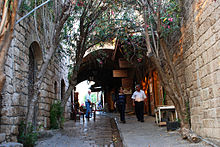
Byblos and all of Lebanon were placed underFrench Mandatefrom 1920 until 1943 when Lebanon achieved independence. The2006 Lebanon Warnegatively affected the ancient city by covering its harbour and town walls with an oil slick that was the result of an oil spill from a nearby power plant.[46]This, however, has been cleared and the coastal area has since then become a destination for beach goers, especially in the late spring and throughout the summer season.
Demographics[edit]
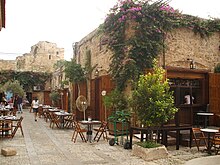
Byblos's inhabitants are predominantly Christian, mostlyMaronite,with minorities ofArmenian Apostolic,Greek Orthodox,andGreek Catholics.There is also a minority ofShia Muslims.It is said that the city ofBint Jbeil( "Daughter of Byblos" ) in southern Lebanon was founded by those Shia Muslims. Byblos has three representatives in theParliament of Lebanon:two Maronites and one Shia.[47][48]
Education[edit]
Byblos is home to the professional schools of theLebanese American University (LAU).The LAU Byblos Campus houses the Medical School, the Engineering School, the School of Architecture and Design, the Pharmacy School, which offers the only Pharm.D. Program outside the United States accredited by theAccreditation Council for Pharmacy Education (ACPE),[49]the School of Business, and the School of Arts and Sciences. The Campus is situated on a hill overlooking the city and theMediterranean Sea.
Tourism[edit]
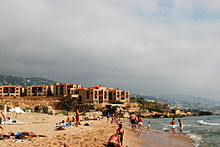

Byblos is re-emerging as an upscale touristic hub.[50]With its ancientport,Phoenician,Roman, and Crusader ruins, sandy beaches and the picturesque mountains that surround it make it an ideal tourist destination. The city is known for its fish restaurants, open-air bars, and outdoor cafes. Yachts cruise into its harbor today as they did in the 1960s and 1970s whenMarlon BrandoandFrank Sinatrawere regular visitors to the city.[50]Byblos was crowned as the "Arab Tour Capital" for the year 2016 by the Lebanese minister of tourism in theGrand SerailinBeirut.Byblos was chosen byCondé Nast Traveleras the second best city in theMiddle Eastfor 2012, beatingTel AvivandDubai,[51]and by theWorld Tourism Organizationas the best Arab tourist city for 2013.[52]
The Byblos archaeological site[edit]
- Ain el-MalikorKing's Spring,about 20 m deep, is a large cavity accessible by spiral stairs. Once it supplied the city with water.[53]According toPlutarch's version of the EgyptianOsiris myth,the king's servants metIsison the stairs of the spring and took her to the royal palace, where she found the body of her husbandOsirisembedded in one of the palace pillars.[54]
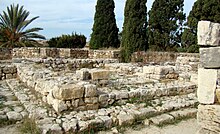
- TheL-shaped Templewas erected about 2700 BC.
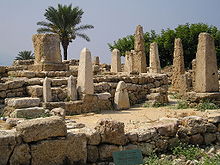
- TheTemple of the Obelisks,originally built in 1600–1200 BC on top of the “L-shaped temple,” was moved by archaeologists to its present location. The many small obelisks found in this temple were used as religious offerings. The sanctuary contained a large number ofhuman figurines made of bronze covered with gold leaf,which are now displayed in theNational Museum of Beirut.
- Theroyal necropolisdates back to the second millennium BC and contains tombs of the Byblos kings, including KingAhiram.
- TheRoman theaterwas built around AD 218.
Other historic buildings[edit]
- Byblos Wax Museum
The Byblos Wax Museum displays wax statues of characters whose dates of origin range fromPhoeniciantimes to current days.
- Byblos Fossil Museum
The Byblos Fossil Museum has a collection of fossilised fish, sharks, eel, flying fish, and other marine life, some of which are millions of years old.
- Medieval city wall
The old medieval part of Byblos is surrounded by walls running about 270m from east to west and 200m from north to south.
- Byblos Castle
Byblos Castle was built by the Crusaders in the 12th century. It is located in the archaeological site near the port.
Work on the church started during the Crusades in 1115. It was considered a cathedral and was partially destroyed during an earthquake in AD 1170. It was later given to the Maronite bishop as a gift by PrinceYusuf Shihab.[55]

- Sultan Abduljid Mosque
The old mosque by the Castle dates back to theMamlukperiod, and adopted the name of SultanAbdulmejid Iafter he renovated it.
- Historic Quarter and Souks
In the southeast section of the historic city, near the entrance of the archaeological site, is an old market where tourists can shop for souvenirs and antiques, or simply stroll along the old cobblestone streets and enjoy the architecture.
- Byblos International Festival
This summer music festival is an annual event that takes place in the historic quarter.
- Temple of Baalat Gebal
- Aram Bezikian Museum
The Armenian Genocide Orphans' Aram Bezikian Museum is a museum dedicated to preserving the memory of the Armenian Genocide and its survivors.[56]
Notable people[edit]
- Majdi Allawi(born 1970), Lebanese Maronite priest, association founder
- Jihad Azour(born 1966), lebanese economist
International relations[edit]
- Twin towns – sister cities
Byblos istwinnedwith:
Gallery[edit]
- Byblos views
Further reading[edit]
- Jidé gian, Nina (1968).Byblos through the ages.Beirut: Dar al Machreq.OCLC7630.
- Thiollet, Jean-Pierre(2005).Je m'appelle Byblos(in French). Paris: H & D.ISBN9782914266048.
- Aubet, Maria Eugenia(2001).The Phoenicians and the West: Politics, Colonies and Trade.Translated by Mary Turton (2d ed.). Cambridge, UK: Cambridge University Press.ISBN978-0521795432.
- Baumgarten, Albert I. (1981).The Phoenician History of Philo of Byblos: A Commentary.Leiden: E. J. Brill.ISBN978-90-04-06369-3.
- Elayi, Josette; Elayi, A. G. (2014).A Monetary and Political History of the Phoenician City of Byblos: In the Fifth and Fourth Centuries B.C.E.Winona Lake, IN: Eisenbrauns.ISBN978-1575063041.
- Kaufman, Asher S. (2004).Reviving Phoenicia: In Search of Identity In Lebanon.London: I.B. Tauris.ISBN978-1780767796.
- Moscati, Sabatino (1999).The World of the Phoenicians.London: Phoenix Giant.ISBN9780753807460.
- Nibbi, Alessandra (1985).Ancient Byblos Reconsidered.Oxford: DE Publications.ISBN0951070401.
See also[edit]
Notes[edit]
- ^abcGarfinkel, Yosef (2004). ""Néolithique" and "Énéolithique" Byblos in Southern Levantine Context ". In E. J. Peltenburg; Alexander Wasse (eds.).Neolithic Revolution: New Perspectives on Southwest Asia in Light of Recent Discoveries on Cyprus.Oxbow Books.ISBN978-1-84217-132-5.Retrieved18 January2012.
- ^abDumper, Michael; Stanley, Bruce E.; Abu-Lughod, Janet L. (2006).Cities of the Middle East and North Africa.ABC-CLIO. p. 104.ISBN1-57607-919-8.Retrieved22 July2009.
Archaeological excavations at Byblos indicate that the site has been continually inhabited since at least 5000 B.C.
- ^Lorenzo Nigro(2007)."Aside the spring: Byblos and Jericho from village to town".In Nigro, Lorenzo (ed.).Byblos and Jericho in the early bronze I: social dynamics and cultural interactions: proceedings of the international workshop held in Rome on March 6th 2007 by Rome "La Sapienza" University.Università di Roma "La Sapienza". p. 35.ISBN978-88-88438-06-1.Archivedfrom the original on 2023-09-23.Retrieved17 February2017.
- ^"Byblos".UNESCO.Retrieved14 March2018.
- ^"Phoenician Alpha bet | Definition, Letters, & History | Britannica".britannica.Retrieved2022-11-11.
- ^abGauthier, Henri (1928).Dictionnaire des Noms Géographiques Contenus dans les Textes Hiéroglyphiques Vol. 5.pp. 197–198.
- ^Wallis Budge, E. A. (1920).An Egyptian hieroglyphic dictionary: with an index of English words, king list and geological list with indexes, list of hieroglyphic characters, coptic and semitic Alpha bets, etc. Vol II.John Murray.p.1047.
- ^de Césarée, E. (1659).Eusebii pamphili caesareae palestinae episcopi Liber de locis hebraicis: Sive onomasticon urbium et locorum Sacrae Scripturae. Nunc primùm Graecè editum, cum Latina versione Sancti Hieronymi. Et variis Additamentis R. P. Jacobi Bonfrerii Soc. Iesu. Unà cum Commentariis ejusdem in Josue, Judices, & Ruth(in Latin). apud Sebastianum Cramoisy Regis & Reginae Architypographum. p. 70.
- ^Wilkinson, Toby (2011).The Rise and Fall of Ancient Egypt.New York, NY: Random House Trade Paperbacks Books. p. 66.ISBN978-0553384901.
- ^Head,et al.(1911),p. 791.
- ^Huss, Werner (1985).Geschichte der Karthager(in German). Munich: C.H. Beck. p.561.ISBN9783406306549..
- ^Ezekiel27:9.
- ^"Byblos Mart -- Bookworms Corner".
- ^Brake, Donald L. (2008).A visual history of the English Bible: the tumultuous tale of the world's bestselling book.Grand Rapids, MI: Baker Books. p.29.ISBN978-0-8010-1316-4.
- ^Eberhart, George M. (2013).The Whole Library Handbook 5: Current Data, Professional Advice, and Curiosa.American Library Association. p. 198.ISBN978-0-8389-1090-0.
- ^Beekes, R. S. P.(2009).Etymological Dictionary of Greek.Leiden and Boston: Brill. pp. 246–7.
- ^abWatson E. Mills; Roger Aubrey Bullard (1990).Mercer dictionary of the Bible.Mercer University Press. pp. 124–.ISBN978-0-86554-373-7.Retrieved8 July2011.
- ^abMoore, A.M.T. (1978).The Neolithic of the Levant.Oxford University, Unpublished Ph.D. Thesis. pp. 329–339.
- ^Montet, Pierre (1928).Byblos et l'Égypte: quatre campagnes de fouilles à Gebeil, 1921-1922-1923-1924.P. Geuthner. p.3.
- [Original French]: "D’abord, le site de Byblos était fixé sans conteste possible. Le passage où Strabon définit Byblos une ville située sur une colline à quelque distance de la nier, avait égaré les savants. Renan lui-même avait songé à Qassouba, mais il comprit vite que cette colline était trop peu importante pour avoir été le siège d’une ville telle que Byblos. L’abondance des fragments antiques recueillis aux environs de la citadelle, la situation des nécropoles au nord et au sud de l’enceinte franque prouvent jusqu'à l’évidence que la ville ne s’est pas déplacée et que Gebeil recouvre Byblos."
- [English translation]: "First, the site of Byblos was fixed without question possible. The passage where Strabon defines Byblos as a city situated on a hill some distance away from it, had misled the scientists. Renan himself had thought of Qassouba, but he soon realised that this hill was too small to have been the seat of a city such as Byblos. The abundance of ancient fragments collected around the citadel, the situation of the necropolises to the north and south of the Frankish enclosure provide the evidence that the city did not move and that Gebeil is Byblos."
- ^"The Theology of the Phœnicians: From Sanchoniatho".sacred-texts.
- ^Cauvin, Jacques., Les industries lithiques du tell de Byblos (Liban), L'Anthropologie, vol. 66, 5–6, 1962.
- ^Vallois, H.V., Note sur les ossements humains de la nécropole énéolithique de Byblos (avec 2 planches).Bulletin du musée de Beyrouth.Tome I, 1937. Beyrouth.
- ^Chehab, Emir M., Tombes des chefs d'époque énéolithique trouvés à Byblos,Bulletin du Musée de Beyrouth.Tome IX, 1949–1950, Beyrouth.
- ^abBoynton, E.S., The Ceramic Industry of Ancient Lebanon. (Available in MS inAmerican University of Beirutand in microfilm inHarvardLibrary) 1960.
- ^Erich, R., Relative chronologies in Old World Archaeology, Chicago, 1954.
- ^Van Liere, W. and Contenson, Henri de, "Holocene Environment and Early Settlement in the Levant",Annales archéologiques de Syrie,volume 14, pp. 125–128, 1964.
- ^Vogel, J.C.Waterbolk, H.T.,Groningen Radiocarbon Dates X, Radiocarbon, 14, 6–110 / 105, 1972.
- ^abLorraine Copeland; P. Wescombe (1965).Inventory of Stone-Age sites in Lebanon, p. 78-79.Imprimerie Catholique.Retrieved21 July2011.[permanent dead link]
- ^Dunand, Maurice., Rapport préliminaire sure les fouilles de Byblos en 1948, 1949,Bulletin du musée de Beyrouth.Tome IX, 1949–1950, Beyrouth.
- ^Dunand, Maurice., Fouilles de Byblos, vol II, Atlas, Paris, 1950d (also part I, 1954 – part II, 1958).
- ^Dunand, Maurice., Chronologie des plus anciennes installations de Byblos, Revue Biblique, vol. 57, 1950b.
- ^Dunand, Maurice., Rapport préliminaire sure les fouilles de Byblos en 1950, 1951 & 1952,Bulletin du musée de Beyrouth.Tome XII, 1955, Beyrouth.
- ^Dunand, Maurice., Rapport préliminaire sure les fouilles de Byblos en 1954, 1955,Bulletin du musée de Beyrouth.Tome XIII, 1956, Beyrouth.
- ^Fleisch, Henri., Préhistoire au Liban en 1950, Bulletin de la Société Préhistorique Français, vol. 48, 1–2, p. 26. (Contains report on Byblos presented by Maurice Dunand to the 3rd C.I.S.E.A., Brussels, 1948), 1951.
- ^Dunand, Maurice., Rapport préliminaire sure les fouilles de Byblos en 1960, 1961 & 1962,Bulletin du musée de Beyrouth.Tome XVII, 1964, Beyrouth.
- ^Dunand, Maurice., Rapport préliminaire sure les fouilles de Byblos en 1957, 1958 & 1959,Bulletin du musée de Beyrouth.Tome XVI, 1961, Beyrouth.
- ^Lorenzo Nigro(2007)."Aside the spring: Byblos and Jericho from village to town".In Nigro, Lorenzo (ed.).Byblos and Jericho in the early bronze I: social dynamics and cultural interactions: proceedings of the international workshop held in Rome on March 6th 2007 by Rome "La Sapienza" University.Università di Roma "La Sapienza". p. 35.ISBN978-88-88438-06-1.Retrieved17 February2017.
- ^Fleisch, Henri., Néolithique du Proche-Orient, Bulletin de la Société Préhistorique Français, vol. 49, 5–6, p. 212. (Contains report on Byblos excavations of 1951 by Maurice Dunand), 1952.
- ^Wilkinson, Toby, 1999,Early Dynastic Egyptp. 78.
- ^"Byblos" in: Encyclopædia Britannica, vol. 2, p. 692. Encyclopædia Britannica, Inc., 1992.ISBN0-85229-553-7
- ^Shaw, Ian: "The Oxford History of Ancient Egypt", page 321. Oxford University Press, 2000.ISBN978-0-19-280458-7
- ^Rogers, Guy MacLean (2021).For the Freedom of Zion: the Great Revolt of Jews against Romans, 66-74 CE.New Haven: Yale University Press. pp. 21–22, 535.ISBN978-0-300-24813-5.
- ^"EMBRIACI in" Enciclopedia Italiana "".treccani.it(in Italian).Retrieved2020-12-15.
- ^Renan, Ernest (1864).Mission de Phénicie.Paris: Imprimerie impériale. p. 157.
- ^Maurice Dunand (1973).Byblos: Its History, Ruins and Legends.Beirut. p. 41.
{{cite book}}:CS1 maint: location missing publisher (link) - ^Dr. Lina G. Tahan."ICOMOS Heritage at Risk 2006/2007"(PDF).ICOMOS.
- ^"Lebanon Elections 2005".Proud-to-be-lebanese. Archived fromthe originalon 2012-12-01.Retrieved2012-10-31.
- ^"Elections municipales et ikhtiariah au Mont-Liban"(PDF).Localiban.2010. p. 19. Archived fromthe original(PDF)on 2015-07-24.Retrieved2016-02-12.
- ^"Lebanese American University".AAICU.2016-02-29.Retrieved2020-09-22.
- ^abBeehner, Lionel (2010-01-03)."Byblos, Lebanon's Ancient Port, Is Reborn".The New York Times.Retrieved2010-04-27.
- ^"Middle East: Top 5 Cities: Readers' Choice Awards: Condé Nast Traveler".Cntraveler. 2012-10-16. Archived fromthe originalon 2013-05-15.Retrieved2013-03-26.
- ^"Byblos crowned best Arab tourist city".Retrieved20 June2013.
- ^"Temple of the Obelisks in Byblos".obelisks.org.
- ^"Isis and Osiris Legend".phoenician.org.
- ^"St. John-Marc Church".jbail-byblos.gov.lb.
- ^Dagher, Rhéa; Kalind gian, Rita (2020). "Paving the way for a Lebanese national narrative: Empathy at the Armenian Genocide Orphans' Aram Bezikian Museum in Lebanon". In Rey, Virginie (ed.).Art of Minorities: Cultural Representation in Museums of the Middle East and North Africa.Edinburgh University Press. p. 180.ISBN978-1-4744-4379-1.
References[edit]
- Head, Barclay; et al. (1911),"Phoenicia",Historia Numorum(2nd ed.), Oxford: Clarendon Press, pp. 788–801
External links[edit]
 Media related toByblosat Wikimedia Commons
Media related toByblosat Wikimedia Commons Byblostravel guide from Wikivoyage
Byblostravel guide from Wikivoyage- "Byblos".Lebanon, the Cedars' Land.
- "Byblos info".middleeast.
- "Embassy of Lebanon in Canada".Byblos.Archived fromthe originalon 2006-10-10.
- "Byblos in Belarus".byblos.by.Archived fromthe originalon 2020-01-22.Retrieved2021-06-15.
- "Radio Carbon Context Database".University of Cologne.Archived fromthe originalon 2011-08-13.Retrieved2011-05-04.
- Baalat ancient deity, chiefly of Byblos
- Byblos
- Populated places in Byblos District
- Christian cities in Lebanon
- Maronite Christian communities in Lebanon
- Populated coastal places in Lebanon
- Mediterranean port cities and towns in Lebanon
- Archaeological sites in Lebanon
- World Heritage Sites in Lebanon
- Populated places established in the 5th millennium BC
- 5th-millennium BC establishments
- Amarna letters locations
- Phoenician cities
- Phoenician sites in Lebanon
- Hellenistic colonies
- Roman sites in Lebanon
- Coloniae (Roman)
- Crusader castles
- Territories of the Republic of Genoa
- Tourism in Lebanon
- Tourist attractions in Lebanon
- Pre-Pottery Neolithic B
- Former kingdoms
- Yarmukian culture


